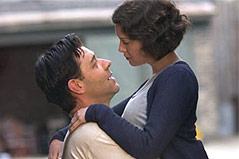
| HOME |
| NERVE |
| REVIEWS |
| ARCHIVE |
| EVENTS |
| LINKS |
| ABOUT US |
| CONTRIBUTORS |
| BACK ISSUES |
| CONTACT US |
 Cinderella
Man (12A)
Cinderella
Man (12A)
Directed by Ron Howard, Written by Cliff Hollingsworth and Akiva Goldsman
On general release from 9th September 2005
Reviewed by Colin Serjent
Based on a true story about the the boxer James R Braddock, Russell Crowe is impressive in the title role, notably for his authentic portrayal inside the ring. The savagery of boxing - fighters were killed on a regular basis in America during the 1930s and 40s - is brilliantly captured by director Ron Howard and director of photography Salvatore Totino, and in some ways it resembles the bloodletting and raw aggression shown in Raging Bull with Robert De Niro.
Braddock made a remarkable rise to fame during the Great Depression. He was seemingly washed up as a boxer, having suffered a series of defeats; he was unemployed and barely able to feed himself, his wife Mae (Renee Zellweger) and children.
His fortunes hit rock bottom when he literally goes cap in hand to a meeting of fight promoters, pleading with them for money to pay his bills.
But his former manager offerd Braddock the chance to return to the fight game, giving him less than 24 hours notice before the planned.contest. Expected to lose in the early rounds he pulled off a major upset by winning the bout. There then followed a succession of stunning victories, ending with him winning the world light heavyweight championship.
However, Cinderella Man is less then convincing outside the ring, with its maudlin representation of massive unemployment and consequent widespread despair, together with the overuse of a sugary orchestral score.
Braddock is also portrayed as an angelic figure, good literally fighting evil, which is hard to swallow. He has no flaws. We are talking about boxing in America, which at that time was heavily corrupt with the Mafia basically in charge, with fights being often fixed, for example.
Nevertheless I enjoyed the film and its old fashioned use of storytelling.
Printer friendly page